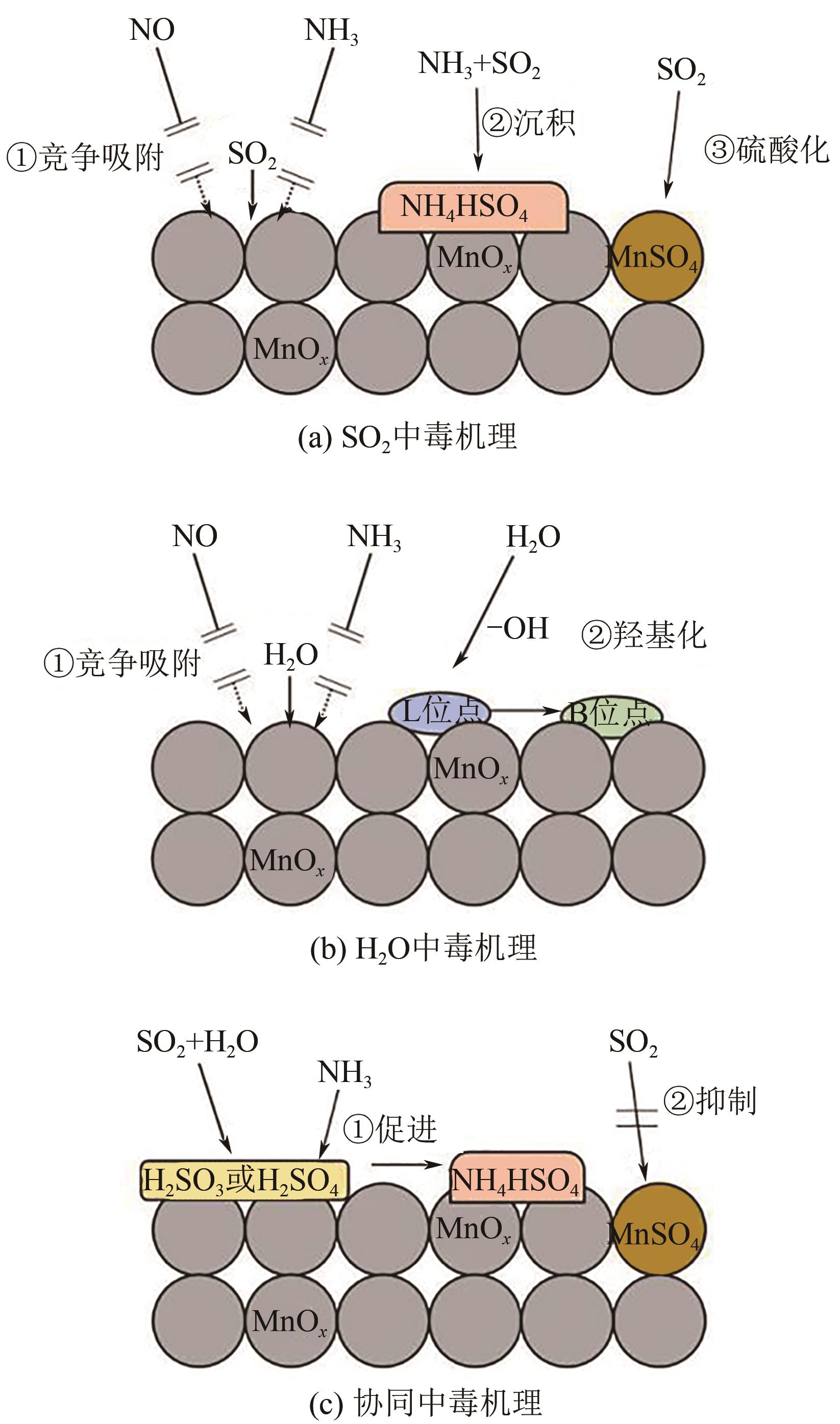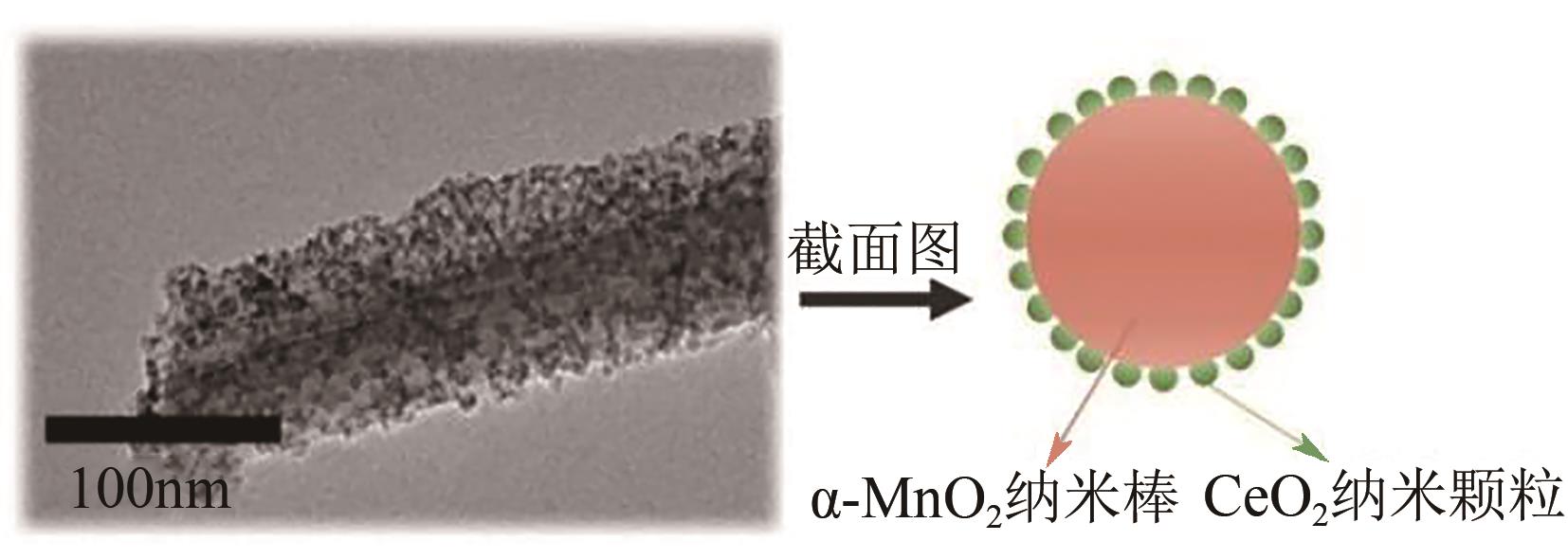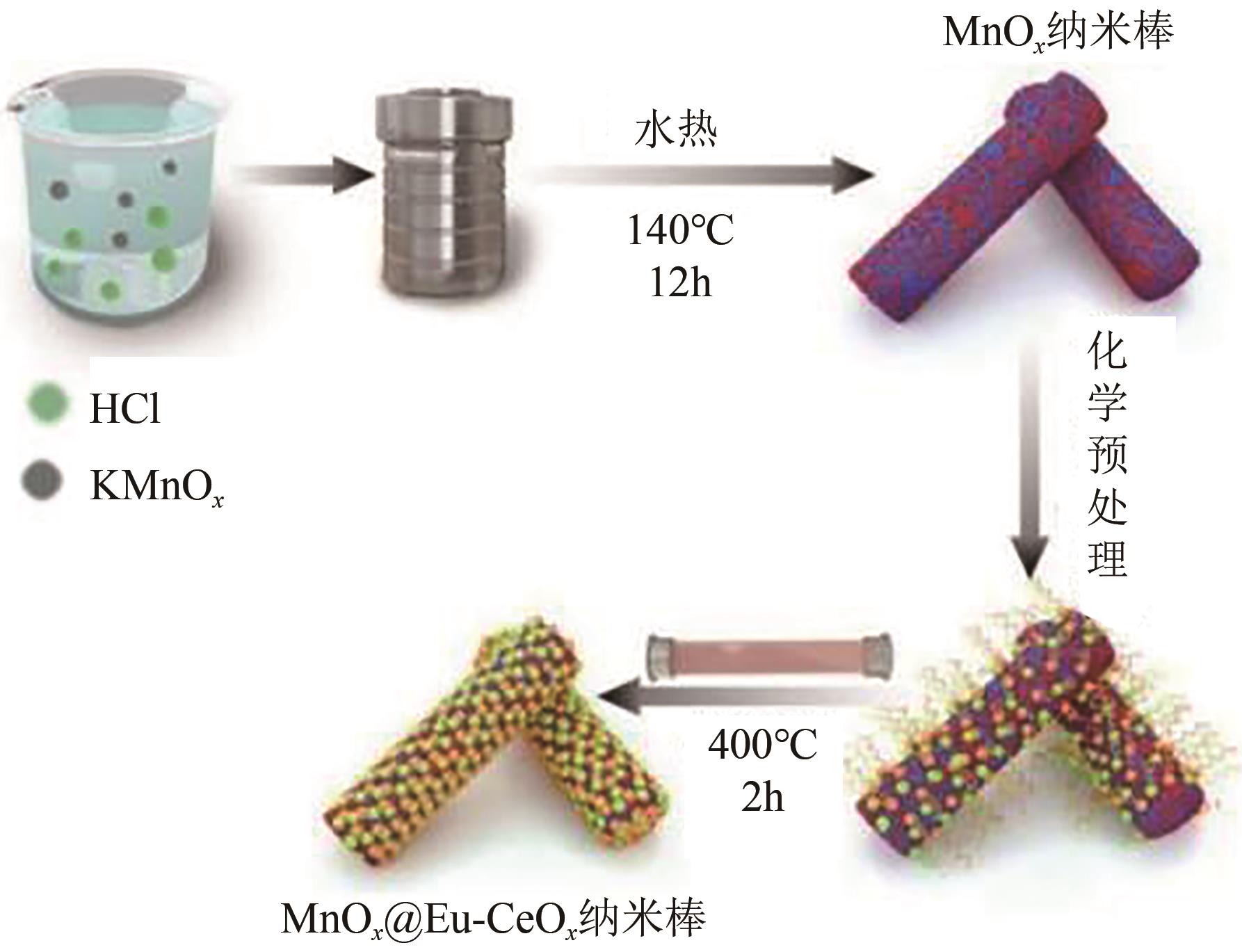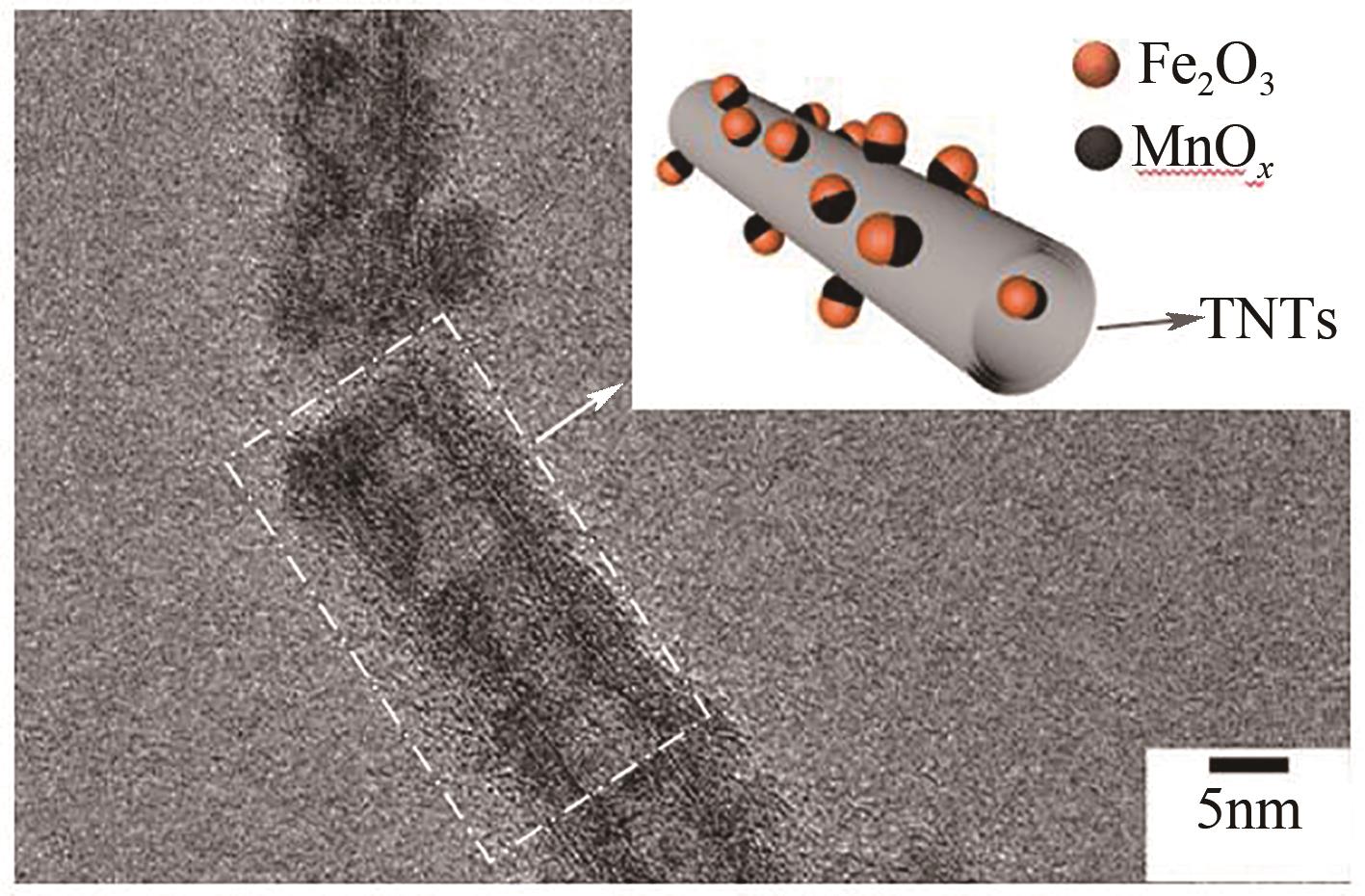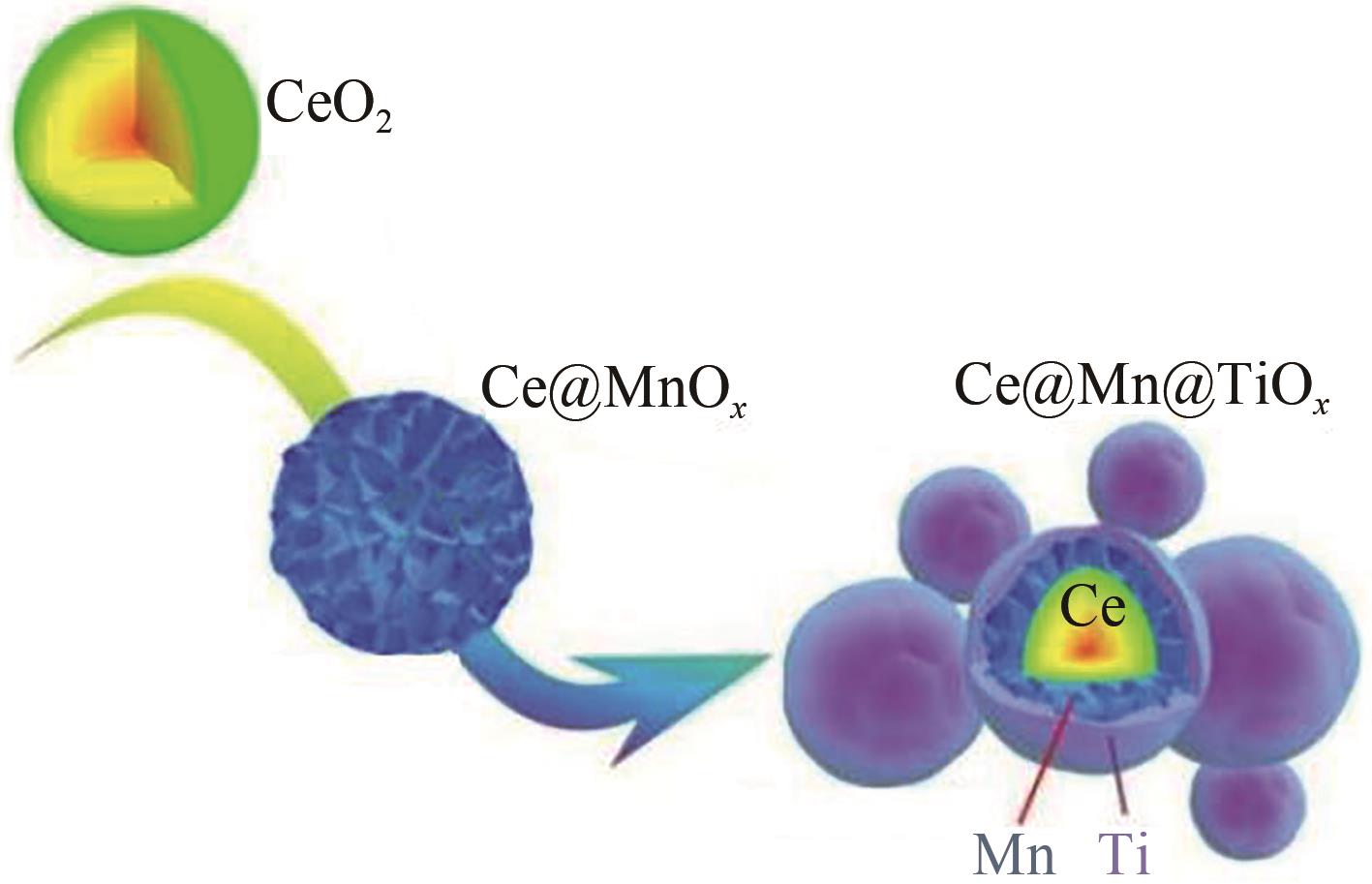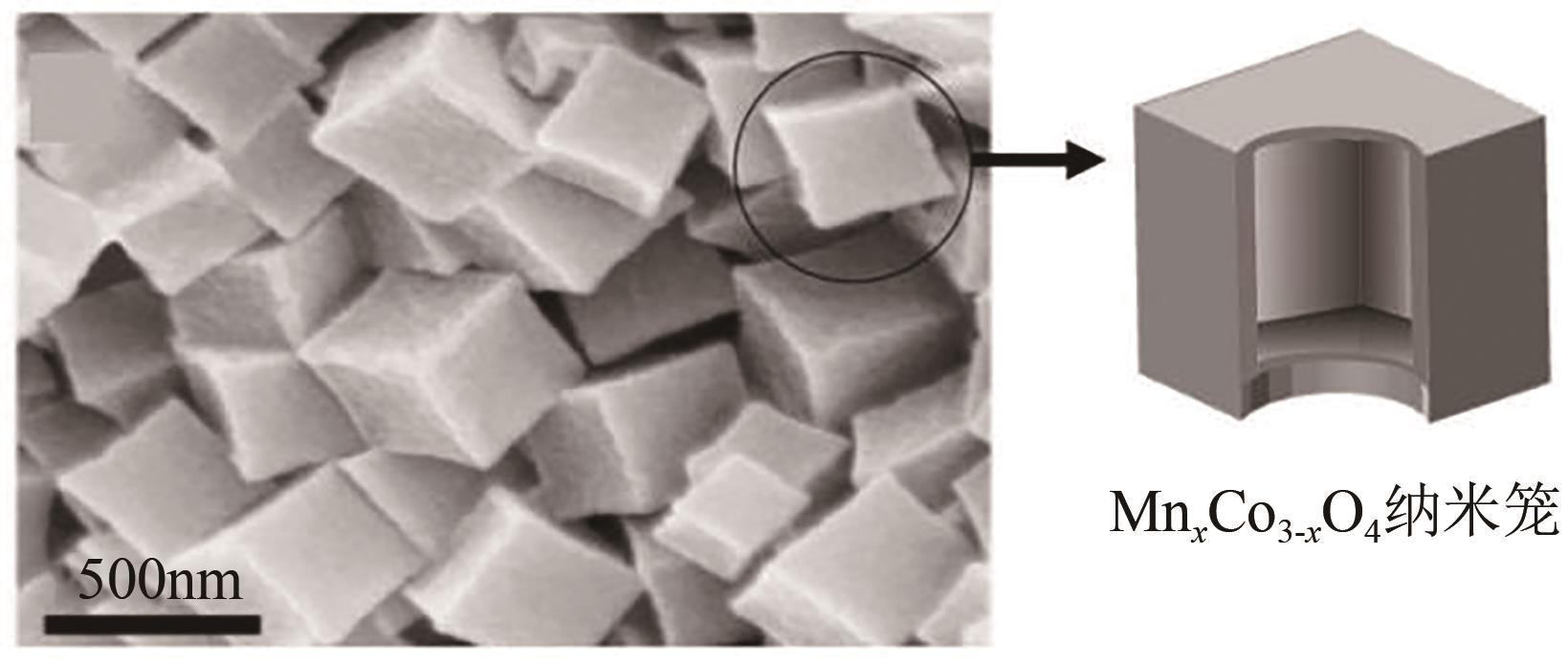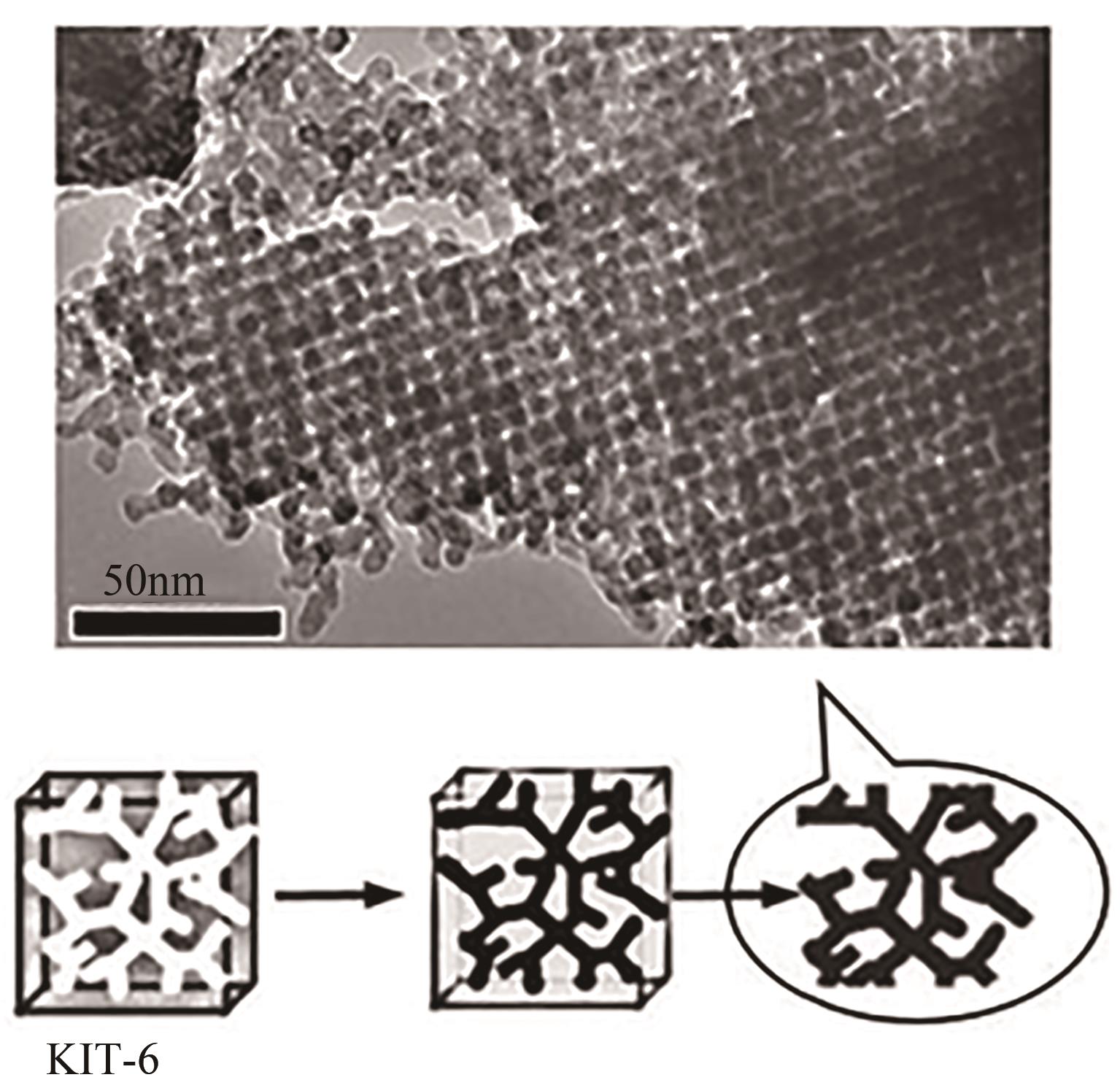Chemical Industry and Engineering Progress ›› 2023, Vol. 42 ›› Issue (1): 226-235.DOI: 10.16085/j.issn.1000-6613.2022-0510
• Industrial catalysis • Previous Articles Next Articles
Effect of structure and morphology on manganese-based catalysts’ sulfur and water resistance
LI Zhaoming1( ), SHEN Boxiong1,2(
), SHEN Boxiong1,2( ), FENG Shuo1, BIAN Yao1
), FENG Shuo1, BIAN Yao1
- 1.School of Energy and Environmental Engineering, Hebei University of Technology, Tianjin 300401, China
2.School of Chemical Engineering, Hebei University of Technology, Tianjin 300401, China
-
Received:2022-03-29Revised:2022-07-07Online:2023-02-20Published:2023-01-25 -
Contact:SHEN Boxiong
锰基催化剂结构形貌对催化剂抗硫抗水性能影响
- 1.河北工业大学能源与环境工程学院,天津 300401
2.河北工业大学化工学院,天津 300401
-
通讯作者:沈伯雄 -
作者简介:李钊铭(1997—),女,硕士研究生,研究方向为大气污染控制。E-mail:450600197@qq.com。 -
基金资助:国家自然科学基金区域联合重点(U20A20302);河北省创新群体(E2021202006);天津科技专项(19ZXSZSN00050);河北省科技专项(20373701D);河北省重大成果转化(21283701Z)
CLC Number:
Cite this article
LI Zhaoming, SHEN Boxiong, FENG Shuo, BIAN Yao. Effect of structure and morphology on manganese-based catalysts’ sulfur and water resistance[J]. Chemical Industry and Engineering Progress, 2023, 42(1): 226-235.
李钊铭, 沈伯雄, 封硕, 边瑶. 锰基催化剂结构形貌对催化剂抗硫抗水性能影响[J]. 化工进展, 2023, 42(1): 226-235.
share this article
Add to citation manager EndNote|Ris|BibTeX
URL: https://hgjz.cip.com.cn/EN/10.16085/j.issn.1000-6613.2022-0510
| 结构 | 示意图 | 特点 | 制备方法 | 引用文献 |
|---|---|---|---|---|
| 核壳结构 |  | 比表面积大、活性位点数量多、表面酸性强;外壳具有屏蔽作用,阻止SO2、H2O与活性组分接触;金属氧化物和分子筛外壳都可促进NH4HSO4分解,阻止沉积物覆盖活性位点;金属氧化物外壳延缓SO2氧化,缓解活性组分硫化反应;金属外壳可作牺牲剂,捕集气相中SO2并优先与SO2反应,保护活性组分;分子筛外壳具有高疏水性,减少H2O在催化剂表面的吸附 | 水热法;化学沉淀法;干凝胶转换法;超声处理浸渍法;化学沉淀电偶置换法 | [ [ |
| 中空结构 |  | 比表面积大,表面酸性强;气体扩散性好,传质效率高;具有羟基吸附位点,可锚定SO2;曲率半径大,蒸发压强,有利于NH4HSO4沉淀分解 | 硬模板法;自组装法;溶剂热法;水热法 | [ [ |
| 三维有序 孔道结构 |  | 孔径均匀、孔道排布规律整齐,增加比表面积和酸性位点;活性组分分散性强,且镶嵌在孔壁中,保护活性组分,减少团聚现象;大孔结构减小毛细作用,降低H2O在催化剂表面吸附,提高了催化剂的耐水性 | 纳米铸造法;软 胶体晶体模板法 | [ [ |
| LDHs衍生二维层状结构 |  | 具有独特的阴阳离子层交错结构,增强层间电子传递,促进氧化还原循环,提高催化剂活性及抗性;具有较大的比表面积,表面酸性强;分散性好,稳定性强,活性组分在催化剂表面不易团聚 | 共沉淀法;尿素 均相沉淀法 | [ |
| 结构 | 示意图 | 特点 | 制备方法 | 引用文献 |
|---|---|---|---|---|
| 核壳结构 |  | 比表面积大、活性位点数量多、表面酸性强;外壳具有屏蔽作用,阻止SO2、H2O与活性组分接触;金属氧化物和分子筛外壳都可促进NH4HSO4分解,阻止沉积物覆盖活性位点;金属氧化物外壳延缓SO2氧化,缓解活性组分硫化反应;金属外壳可作牺牲剂,捕集气相中SO2并优先与SO2反应,保护活性组分;分子筛外壳具有高疏水性,减少H2O在催化剂表面的吸附 | 水热法;化学沉淀法;干凝胶转换法;超声处理浸渍法;化学沉淀电偶置换法 | [ [ |
| 中空结构 |  | 比表面积大,表面酸性强;气体扩散性好,传质效率高;具有羟基吸附位点,可锚定SO2;曲率半径大,蒸发压强,有利于NH4HSO4沉淀分解 | 硬模板法;自组装法;溶剂热法;水热法 | [ [ |
| 三维有序 孔道结构 |  | 孔径均匀、孔道排布规律整齐,增加比表面积和酸性位点;活性组分分散性强,且镶嵌在孔壁中,保护活性组分,减少团聚现象;大孔结构减小毛细作用,降低H2O在催化剂表面吸附,提高了催化剂的耐水性 | 纳米铸造法;软 胶体晶体模板法 | [ [ |
| LDHs衍生二维层状结构 |  | 具有独特的阴阳离子层交错结构,增强层间电子传递,促进氧化还原循环,提高催化剂活性及抗性;具有较大的比表面积,表面酸性强;分散性好,稳定性强,活性组分在催化剂表面不易团聚 | 共沉淀法;尿素 均相沉淀法 | [ |
| 1 | 姚程. 低温脱硝催化剂抗水性研究进展[J]. 四川化工, 2019, 22(2): 9-11. |
| YAO Cheng. Research progress on water resistance of low temperature denitration catalysts[J]. Sichuan Chemical Industry, 2019, 22(2): 9-11. | |
| 2 | 樊改肖. 浅谈机动车尾气中氮氧化物减排技术的发展[J]. 内燃机与配件, 2019 (13): 258-259. |
| FAN Gaixiao. Talking about the purification technologies of nitrogen oxides in vehicle exhaust gas[J]. Internal Combustion Engine & Parts, 2019 (13): 258-259. | |
| 3 | 张贺, 秘雪岳, 孙妍, 等. NH3-SCR脱硝技术的研究现状与展望[J]. 实验室科学, 2019, 22(6): 6-10. |
| ZHANG He, MI Xueyue, SUN Yan, et al. Research status and prospects of NH3-SCR denitration technology[J]. Laboratory Science, 2019, 22(6): 6-10. | |
| 4 | 赵中昆, 陈鑫, 许志志. MnO x -基催化剂低温NH3-SCR脱硝研究进展[J]. 环境科学导刊, 2021, 40(1): 1-7. |
| ZHAO Zhongkun, CHEN Xin, XU Zhizhi. Research progress of low-temperature NH3-SCR of denitration for MnO x -based catalysts[J]. Environmental Science Survey, 2021, 40(1): 1-7. | |
| 5 | 谭月, 张小龙, 杜媛. SCR烟气脱硝催化剂研究进展[J]. 环境保护与循环经济, 2019, 39(11): 32-34. |
| TAN Yue, ZHANG Xiaolong, DU yuan. Research progress of SCR flue gas denitration catalyst[J]. Environmental Protection and Circular Economy, 2019, 39(11): 32-34. | |
| 6 | 陈东. 低温NH3-SCR脱硝催化剂研究进展[J]. 四川化工, 2016, 19(2): 42-44. |
| CHEN Dong. Research progress in low temperature NH3-SCR of De-NO x catalysts[J]. Sichuan Chemical Industry, 2016, 19(2): 42-44. | |
| 7 | 李亚倩, 李建军, 李海娇. 低温NH3-SCR脱硝催化剂研究现状及进展[J]. 四川化工, 2018, 21(2): 13-15/29. |
| LI Yaqian, LI Jianjun, LI Haijiao. Research status and progress of low temperature NH3-SCR denitration catalyst[J]. Sichuan Chemical Industry, 2018, 21(2): 13-15/29. | |
| 8 | SUN Chuanzhi, CHEN Wei, JIA Xuanxuan, et al. Comprehensive understanding of the superior performance of Sm-modified Fe2O3 catalysts with regard to NO conversion and H2O/SO2 resistance in the NH3-SCR reaction[J]. Chinese Journal of Catalysis, 2021, 42(3): 417-430. |
| 9 | XIONG Yan, TANG Changjin, YAO Xiaojiang, et al. Effect of metal ions doping (M=Ti4+, Sn4+) on the catalytic performance of MnO x /CeO2 catalyst for low temperature selective catalytic reduction of NO with NH3 [J]. Applied Catalysis A: General, 2015, 495: 206-216. |
| 10 | ZHANG Huawei, ZHANG Mingzhu, HAO Lifeng, et al. Enhanced SO2 tolerance of FeCeO x /CNTs catalyst for NO and Hg0 removal by coating shell SiO2 [J]. Fuel Processing Technology, 2020, 201: 106342. |
| 11 | MA Kaili, GUO Kai, LI Lulu, et al. Cavity size dependent SO2 resistance for NH3-SCR of hollow structured CeO2-TiO2 catalysts[J]. Catalysis Communications, 2019, 128: 105719. |
| 12 | LIU Yan, XU Jing, LI Hongrui, et al. Rational design and in situ fabrication of MnO2@NiCo2O4 nanowire arrays on Ni foam as high-performance monolith de-NO x catalysts[J]. Journal of Materials Chemistry A, 2015, 3(21): 11543-11553. |
| 13 | 李晨露, 唐晓龙, 易红宏, 等. Mn基低温SCR催化剂的抗H2O、抗SO2研究进展[J]. 化工进展, 2017, 36(3): 934-943. |
| LI Chenlu, TANG Xiaolong, YI Honghong, et al. Review on manganese based catalysts resistant to H2O and SO2 for SCR reduction at low temperature[J]. Chemical Industry and Engineering Progress, 2017, 36(3): 934-943. | |
| 14 | 赵琳, 刘庆岭, 胡芝娟, 等. 提高Mn系低温脱硝催化剂抗硫抗水性能的国内外研究概述[J]. 水泥技术, 2020(2): 66-72. |
| ZHAO Lin, LIU Qingling, HU Zhijuan, et al. Overview of domestic and overseas studies on improving the sulfur and water resistance performance of Mn-based low temperature SCR catalysts[J]. Cement Technology, 2020(2): 66-72. | |
| 15 | HU Xiaolei, SHI Qiang, ZHANG He, et al. NH3-SCR performance improvement over Mo modified Mo( x)-MnO x nanorods at low temperatures[J]. Catalysis Today, 2017, 297: 17-26. |
| 16 | LIU Fudong, HE Hong. Selective catalytic reduction of NO with NH3 over manganese substituted iron titanate catalyst: Reaction mechanism and H2O/SO2 inhibition mechanism study[J]. Catalysis Today, 2010, 153(3/4): 70-76. |
| 17 | YAN Qinghua, CHEN Sining, ZHANG Cheng, et al. Synthesis and catalytic performance of Cu1Mn0.5Ti0.5O x mixed oxide as low-temperature NH3-SCR catalyst with enhanced SO2 resistance[J]. Applied Catalysis B: Environmental, 2018, 238: 236-247. |
| 18 | SHI Xueke, GUO Jiaxiu, SHEN Ting, et al. Enhancement of Ce doped La-Mn oxides for the selective catalytic reduction of NO x with NH3 and SO2 and/or H2O resistance[J]. Chemical Engineering Journal, 2021, 421: 129995. |
| 19 | WANG Qiulin, WANG Rui, HUANG Xiaoniu, et al. Sulfur/water resistance and regeneration of MnO x -CeO2/TiO2 catalyst for low-temperature selective catalytic reduction of NO x [J]. Journal of Environmental Chemical Engineering, 2022, 10(2): 107345. |
| 20 | SCHILL L, PUTLURU S S R, JENSEN A D, et al. MnFe/Al2O3 catalyst synthesized by deposition precipitation for low-temperature selective catalytic reduction of NO with NH3 [J]. Catalysis Letters, 2015, 145(9): 1724-1732. |
| 21 | ZHANG Ningqiang, HE Hong, WANG Dingsheng, et al. Challenges and opportunities for manganese oxides in low-temperature selective catalytic reduction of NO x with NH3: H2O resistance ability[J]. Journal of Solid State Chemistry, 2020, 289: 121464. |
| 22 | 程姝媛. 中空核壳结构MnO x @PrO x 催化剂的合成及低温NH3-SCR催化性能研究[D]. 广州: 华南理工大学, 2020. |
| CHENG Suyuan. Synthesis of hollow MnO x @PrO x core-shell catalyst and catalytic performance of low temperature NH3-SCR[D]. Guangzhou: South China University of Technology, 2020. | |
| 23 | GAN Lina, LI Kezhi, YANG Weinan, et al. Core-shell-like structured α-MnO2@CeO2 catalyst for selective catalytic reduction of NO: promoted activity and SO2 tolerance[J]. Chemical Engineering Journal, 2020, 391: 123473. |
| 24 | YU Chenglong, HOU Dan, HUANG Bichun, et al. A MnO x @Eu-CeO x nanorod catalyst with multiple protective effects: strong SO2-tolerance for low temperature DeNO x processes[J]. Journal of Hazardous Materials, 2020, 399: 123011. |
| 25 | CHI Bin, QU Hongxia, XING Xiang, et al. Assembly of hollow CeO2@Fe-ZSM-5 and SCR performance[J]. Journal of Alloys and Compounds, 2017, 726: 906-912. |
| 26 | YAN Ran, LIN Sixue, LI Yonglong, et al. Novel shielding and synergy effects of Mn-Ce oxides confined in mesoporous zeolite for low temperature selective catalytic reduction of NO x with enhanced SO2/H2O tolerance[J]. Journal of Hazardous Materials, 2020, 396: 122592. |
| 27 | LI Yifan, HOU Yaqin, ZHANG Yongzhao, et al. Confinement of MnO x @Fe2O3 core-shell catalyst with titania nanotubes: Enhanced N2 selectivity and SO2 tolerance in NH3-SCR process[J]. Journal of Colloid and Interface Science, 2022, 608: 2224-2234. |
| 28 | HUANG Xiaosheng, DONG Fang, ZHANG Guodong, et al. A strategy for constructing highly efficient yolk-shell Ce@Mn@TiO x catalyst with dual active sites for low-temperature selective catalytic reduction of NO with NH3 [J]. Chemical Engineering Journal, 2021, 419: 129572. |
| 29 | ZHANG Lei, WU Haobin, LOU Xiongwen. Metal-organic-frameworks-derived general formation of hollow structures with high complexity[J]. Journal of the American Chemical Society, 2013, 135(29): 10664-10672. |
| 30 | CHEN Xiaoping, LIU Qi, WU Qin, et al. A hollow structure WO3@CeO2 catalyst for NH3-SCR of NO x [J]. Catalysis Communications, 2021, 149: 106252. |
| 31 | LI Chenlu, TANG Xiaolong, YI Honghong, et al. Rational design of template-free MnO x -CeO2 hollow nanotube as de-NO x catalyst at low temperature[J]. Applied Surface Science, 2018, 428: 924-932. |
| 32 | LI Yi, LI Yanping, SHI Qiang, et al. Novel hollow microspheres Mn x Co3- x O4 (x=1, 2) with remarkable performance for low-temperature selective catalytic reduction of NO with NH3 [J]. Journal of Sol-Gel Science and Technology, 2017, 81(2): 576-585. |
| 33 | ZHANG Lei, SHI Liyi, HUANG Lei, et al. Rational design of high-performance DeNO x catalysts based on Mn x Co3- x O4 nanocages derived from metal-organic frameworks[J]. ACS Catalysis, 2014, 4(6): 1753-1763. |
| 34 | SHI Yiran, YI Honghong, GAO Fengyu, et al. Facile synthesis of hollow nanotube MnCoO x catalyst with superior resistance to SO2 and alkali metal poisons for NH3-SCR removal of NO x [J]. Separation and Purification Technology, 2021, 265: 118517. |
| 35 | QIU Mingying, ZHAN Sihui, YU Hongbing, et al. Low-temperature selective catalytic reduction of NO with NH3 over ordered mesoporous Mn x Co3- x O4 catalyst[J]. Catalysis Communications, 2015, 62: 107-111. |
| 36 | QIU Mingying, ZHAN Sihui, ZHU Dandan, et al. NH3-SCR performance improvement of mesoporous Sn modified Cr-MnO x catalysts at low temperatures[J]. Catalysis Today, 2015, 258: 103-111. |
| 37 | YU Shuohan, JIANG Ningxin, ZOU Weixin, et al. A general and inherent strategy to improve the water tolerance of low temperature NH3-SCR catalysts via trace SiO2 deposition[J]. Catalysis Communications, 2016, 84: 75-79. |
| 38 | QIU Mingying, ZHAN Sihui, YU Hongbing, et al. Facile preparation of ordered mesoporous MnCo2O4 for low-temperature selective catalytic reduction of NO with NH3 [J]. Nanoscale, 2015, 7(6): 2568-2577. |
| 39 | GAO Xin, LI Ling, SONG Lihong, et al. Highly dispersed MnO x nanoparticles supported on three-dimensionally ordered macroporous carbon: a novel nanocomposite for catalytic reduction of NO x with NH3 at low temperature[J]. RSC Advances, 2015, 5(37): 29577-29588. |
| 40 | YAN Qinghua, HOU Xiangting, LIU Guocheng, et al. Recent advances in layered double hydroxides (LDHs) derived catalysts for selective catalytic reduction of NO x with NH3 [J]. Journal of Hazardous Materials, 2020, 400: 123260. |
| 41 | WANG Ruihua, HAO Zhifei, LI Yi, et al. Relationship between structure and performance of a novel highly dispersed MnO x on Co-Al layered double oxide for low temperature NH3-SCR[J]. Applied Catalysis B: Environmental, 2019, 258: 117983. |
| 42 | ZHOU Xia, YU Feng, SUN Ruobing, et al. Two-dimensional MnFeCo layered double oxide as catalyst for enhanced selective catalytic reduction of NO x with NH3 at low temperature (25-150℃)[J]. Applied Catalysis A: General, 2020, 592: 117432. |
| 43 | NIE Yu, YAN Qinghua, CHEN Sining, et al. CuTi LDH derived NH3-SCR catalysts with highly dispersed CuO active phase and improved SO2 resistance[J]. Catalysis Communications, 2017, 97: 47-50. |
| 44 | CHEN Sining, YAN Qinghua, ZHANG Cheng, et al. A novel highly active and sulfur resistant catalyst from Mn-Fe-Al layered double hydroxide for low temperature NH3-SCR[J]. Catalysis Today, 2019, 327: 81-9. |
| 45 | LI Xiaojian, DU Yali, GUO Xingmei, et al. Synthesis of a novel NiMnTi mixed metal oxides from LDH precursor and its catalytic application for selective catalytic reduction of NO x with NH3 [J]. Catalysis Letters, 2019, 149(2): 456-464. |
| 46 | CAI Ziguo, ZHANG Guodong, TANG Zhicheng, et al. MnFeO x @TiO2 nanocages for selective catalytic reduction of NO with NH3 at low temperature[J]. ACS Applied Nano Materials, 2021, 4(6): 6201-6211. |
| 47 | ZHANG Lei, ZHANG Dengsong, ZHANG Jianping, et al. Design of meso-TiO2@MnO x -CeO x /CNTs with a core-shell structure as DeNO x catalysts: Promotion of activity, stability and SO2-tolerance[J]. Nanoscale, 2013, 5(20): 9821-9829. |
| 48 | CAI Sixiang, ZHANG Dengsong, ZHANG Lei, et al. Comparative study of 3D ordered macroporous Ce0.75Zr0.2M0.05O2- δ (M=Fe, Cu, Mn, Co) for selective catalytic reduction of NO with NH3 [J]. Catalysis Science & Technology, 2014, 4(1): 93-101. |
| 49 | LI Wei, MA Qiong, WANG Xiao, et al. Enhanced photoresponse and fast charge transfer: Three-dimensional macroporous g-C3N4/GO-TiO2 nanostructure for hydrogen evolution[J]. Journal of Materials Chemistry A, 2020, 8(37):19533-19543. |
| 50 | LI Yonglong, YANG Shenyou, PENG Honggen, et al. Insight into the activity and SO2 tolerance of hierarchically ordered MnFe1- δ Co δ O x ternary oxides for low-temperature selective catalytic reduction of NO x with NH3 [J]. Journal of Catalysis, 2021, 395: 195-209. |
| [1] | HU Xi, WANG Mingshan, LI Enzhi, HUANG Siming, CHEN Junchen, GUO Bingshu, YU Bo, MA Zhiyuan, LI Xing. Research progress on preparation and sodium storage properties of tungsten disulfide composites [J]. Chemical Industry and Engineering Progress, 2023, 42(S1): 344-355. |
| [2] | XU Chunshu, YAO Qingda, LIANG Yongxian, ZHOU Hualong. Research progress on functionalization strategies of covalent organic frame materials and its adsorption properties for Hg(Ⅱ) and Cr(Ⅵ) [J]. Chemical Industry and Engineering Progress, 2023, 42(S1): 461-478. |
| [3] | XU Ruosi, TAN Wei. Flow field simulation and fluid-structure coupling analysis of C-tube pool boiling two-phase flow model [J]. Chemical Industry and Engineering Progress, 2023, 42(S1): 47-55. |
| [4] | DENG Liping, SHI Haoyu, LIU Xiaolong, CHEN Yaoji, YAN Jingying. Non-noble metal modified vanadium titanium-based catalyst for NH3-SCR denitrification simultaneous control VOCs [J]. Chemical Industry and Engineering Progress, 2023, 42(S1): 542-548. |
| [5] | XU Chenyang, DU Jian, ZHANG Lei. Chemical reaction evaluation based on graph network [J]. Chemical Industry and Engineering Progress, 2023, 42(S1): 205-212. |
| [6] | WANG Shengyan, DENG Shuai, ZHAO Ruikai. Research progress on carbon dioxide capture technology based on electric swing adsorption [J]. Chemical Industry and Engineering Progress, 2023, 42(S1): 233-245. |
| [7] | CHENG Tao, CUI Ruili, SONG Junnan, ZHANG Tianqi, ZHANG Yunhe, LIANG Shijie, PU Shi. Analysis of impurity deposition and pressure drop increase mechanisms in residue hydrotreating unit [J]. Chemical Industry and Engineering Progress, 2023, 42(9): 4616-4627. |
| [8] | WANG Jingang, ZHANG Jianbo, TANG Xuejiao, LIU Jinpeng, JU Meiting. Research progress on modification of Cu-SSZ-13 catalyst for denitration of automobile exhaust gas [J]. Chemical Industry and Engineering Progress, 2023, 42(9): 4636-4648. |
| [9] | GAO Yanjing. Analysis of international research trend of single-atom catalysis technology [J]. Chemical Industry and Engineering Progress, 2023, 42(9): 4667-4676. |
| [10] | CHEN Xiangyu, BIAN Chunlin, XIAO Benyi. Research progress on temperature phased anaerobic digestion technology [J]. Chemical Industry and Engineering Progress, 2023, 42(9): 4872-4881. |
| [11] | WU Haibo, WANG Xilun, FANG Yanxiong, JI Hongbing. Progress of the development and application of 3D printing catalyst [J]. Chemical Industry and Engineering Progress, 2023, 42(8): 3956-3964. |
| [12] | LI Bogeng, LUO Yingwu, LIU Pingwei. Consideration on research content and method of polymer product engineering [J]. Chemical Industry and Engineering Progress, 2023, 42(8): 3905-3909. |
| [13] | LI Runlei, WANG Ziyan, WANG Zhimiao, LI Fang, XUE Wei, ZHAO Xinqiang, WANG Yanji. Efficient catalytic performance of CuO-CeO2/TiO2 for CO oxidation at low-temperature [J]. Chemical Industry and Engineering Progress, 2023, 42(8): 4264-4274. |
| [14] | ZHANG Yaojie, ZHANG Chuanxiang, SUN Yue, ZENG Huihui, JIA Jianbo, JIANG Zhendong. Application of coal-based graphene quantum dots in supercapacitors [J]. Chemical Industry and Engineering Progress, 2023, 42(8): 4340-4350. |
| [15] | ZHAO Jian, ZHUO Zewen, DONG Hang, GAO Wenjian. A new method for observation of microstructure of waxy crude oil and its emulsion system [J]. Chemical Industry and Engineering Progress, 2023, 42(8): 4372-4384. |
| Viewed | ||||||
|
Full text |
|
|||||
|
Abstract |
|
|||||
